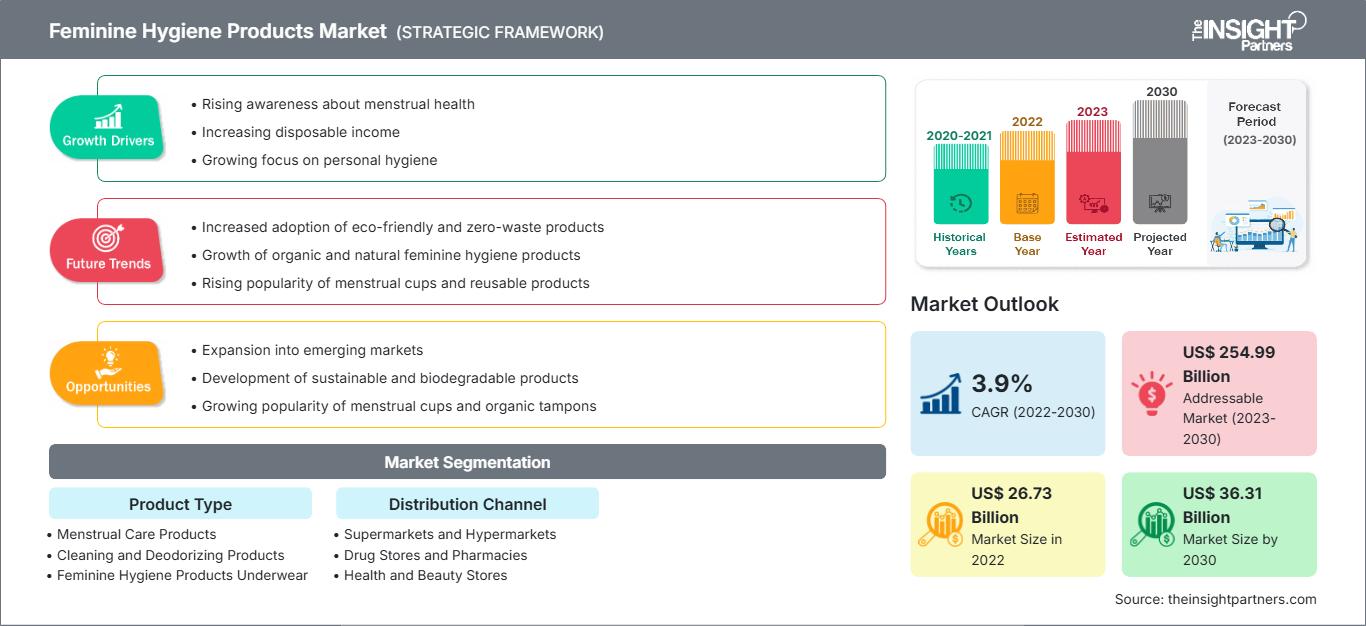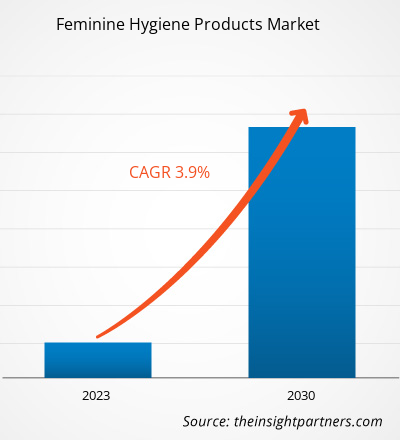[Rapporto di ricerca] Il mercato dei prodotti per l'igiene femminile è stato valutato a 26.733,33 milioni di dollari nel 2022 e si prevede che raggiungerà i 36.305,29 milioni di dollari entro il 2030; si prevede che registrerà un CAGR del 3,9% dal 2022 al 2030. Approfondimenti di mercato e punto di vista degli analisti:
Il mercato dei prodotti per l'igiene femminile in Europa è trainato principalmente da una crescente consapevolezza verso la cura dell'igiene personale e dalle crescenti iniziative degli enti governativi in materia di igiene femminile. Inoltre, la consapevolezza riguardo all'igiene personale tra le donne è in aumento grazie a varie iniziative governative e campagne sui social media. Queste iniziative e campagne contribuiscono a una migliore comprensione e accettazione dei prodotti per l'igiene femminile. Pertanto, la crescente consapevolezza verso l'igiene personale sta stimolando la crescita del mercato dei prodotti per l'igiene femminile. Regioni come Nord America, Europa e Asia-Pacifico sono il fulcro di Edgewell Personal Care Co, Kimberly-Clark Corp, Lune Group Oy Ltd, Me Luna Gmbh, Mooncup Ltd, Ontex BV, Essity Ab, Wuka Ltd, Cotton High Tech SL e The Procter & Gamble Co, che generano un'elevata domanda di prodotti per l'igiene intima. Pertanto, la presenza di tali aziende guida la crescita del mercato globale dei prodotti per l'igiene intima.
Fattori di crescita e sfide:
Le iniziative strategiche dei principali attori del mercato hanno guidato la crescita del mercato globale dei prodotti per l'igiene intima. I produttori stanno investendo massicciamente in progetti di ricerca e sviluppo, partnership, piani di espansione e collaborazioni per lanciare prodotti innovativi e attrarre un'ampia base di consumatori. Ad esempio, a giugno 2020, Pee Safe ha lanciato una nuova gamma di prodotti per l'igiene intima, tra cui spray igienizzante per indumenti intimi, assorbenti igienici riutilizzabili, sacchetti monouso oxo-biodegradabili e una polvere per l'igiene intima. I principali attori del mercato stanno adottando iniziative strategiche come fusioni e acquisizioni per espandere il proprio portafoglio prodotti e la propria presenza geografica. Ad esempio, nel novembre 2022, Edgewell Personal Care ha annunciato l'acquisizione di Billie Inc. L'acquisizione mirava ad ampliare il proprio portafoglio prodotti di marchi leader nel settore della rasatura femminile e della cura del corpo.
Inoltre, i prodotti per la depilazione naturali e puliti stanno guadagnando popolarità in tutto il mondo grazie alla maggiore consapevolezza degli effetti nocivi delle sostanze chimiche e alla crescente propensione all'utilizzo di prodotti per la cura della persona ecologici e puliti. Questa tendenza ha spinto i produttori a sviluppare prodotti naturali in base alle esigenze dei clienti. Ad esempio, Reckitt Benckiser Group Plc ha lanciato la gamma di creme depilatorie Veet Pure nel 2022, riformulando così i propri prodotti. La gamma di prodotti include estratti naturali di cetriolo, aloe vera e olio di vinaccioli. Pertanto, il lancio di tali prodotti e altre strategie per soddisfare la crescente domanda dei consumatori contribuiscono alla crescita del mercato.
Personalizza questo rapporto in base alle tue esigenze
Potrai personalizzare gratuitamente qualsiasi rapporto, comprese parti di questo rapporto, o analisi a livello di paese, pacchetto dati Excel, oltre a usufruire di grandi offerte e sconti per start-up e università
Mercato dei prodotti per l'igiene femminile: Approfondimenti strategici

-
Ottieni le principali tendenze chiave del mercato di questo rapporto.Questo campione GRATUITO includerà l'analisi dei dati, che vanno dalle tendenze di mercato alle stime e alle previsioni.
Il mercato globale dei prodotti per l'igiene femminile è segmentato in base alla tipologia di prodotto, al canale di distribuzione e all'area geografica. In base alla tipologia di prodotto, il mercato dei prodotti per l'igiene femminile è segmentato in prodotti per l'igiene mestruale, prodotti per la pulizia e la deodorizzazione e biancheria intima per l'igiene femminile. In base al canale di distribuzione, il mercato dei prodotti per l'igiene femminile è segmentato in supermercati e ipermercati, farmacie, negozi di prodotti per la salute e la bellezza, vendita al dettaglio online e altri. Il mercato dei prodotti per l'igiene femminile, in base all'area geografica, è segmentato in Nord America (Stati Uniti, Canada e Messico), Europa (Germania, Francia, Italia, Regno Unito, Russia e resto d'Europa), Asia Pacifico (Australia, Cina, Giappone, India, Corea del Sud e resto dell'Asia Pacifico), Medio Oriente e Africa (Sudafrica, Arabia Saudita, Emirati Arabi Uniti e resto del Medio Oriente e Africa) e Sud e Africa. America Centrale (Brasile, Argentina e resto del Sud e Centro America).
Analisi Segmentale:
In base alla tipologia di prodotto, il mercato dei prodotti per l'igiene femminile è segmentato in prodotti per l'igiene mestruale, prodotti per la pulizia e la deodorizzazione e biancheria intima per l'igiene femminile. Il segmento dei prodotti per l'igiene mestruale ha detenuto una quota significativa nella crescita del mercato dei prodotti per l'igiene femminile e si prevede che registrerà una crescita sostanziale durante il periodo di previsione. I prodotti per l'igiene mestruale, tra cui assorbenti, mutandine mestruali, salvaslip, salviette umidificate, tamponi e coppette mestruali, assorbenti igienici e assorbenti, stanno guadagnando terreno grazie alla crescente consapevolezza dell'igiene femminile tra le donne in tutto il mondo. Inoltre, il crescente utilizzo di questi prodotti sta incoraggiando la sensibilità ambientale tra la popolazione. Pertanto, le professioniste e altre popolazioni sensibili all'ambiente stanno adottando prodotti per l'igiene mestruale comodi e monouso.
I prodotti per l'igiene mestruale vengono solitamente smaltiti e finiscono in discarica, generando enormi volumi di rifiuti non biodegradabili. Di conseguenza, persistono nell'ambiente sotto forma di microplastiche, rappresentando una minaccia significativa per gli ecosistemi acquatici e terrestri. Grazie alla crescente consapevolezza di questo problema, molte persone stanno passando a prodotti riutilizzabili per l'igiene mestruale, come coppette mestruali, dischi mestruali e assorbenti in tessuto. Secondo un articolo pubblicato sul sito web della BBC e sull'indice dei termini di ricerca di Google Trends, le ricerche di prodotti riutilizzabili per il ciclo mestruale sono aumentate di anno in anno.
Analisi regionale:
In base alla geografia, il mercato dei prodotti per l'igiene femminile è suddiviso in cinque regioni chiave: Nord America, Europa, Asia-Pacifico, America meridionale e centrale e Medio Oriente e Africa. Il mercato globale dei prodotti per l'igiene femminile è stato dominato dal Nord America e ha registrato circa 5.000 milioni di dollari nel 2022. L'Europa è il secondo principale contributore, con una quota di mercato globale superiore al 20%. Si prevede che l'area Asia-Pacifico crescerà a un CAGR superiore al 5% durante il periodo di previsione. Il mercato nordamericano dei prodotti per l'igiene femminile è segmentato in Stati Uniti, Canada e Messico. La crescita del mercato dei prodotti per l'igiene femminile in Nord America è attribuita a un tenore di vita più elevato, a migliori pratiche igienico-sanitarie e a livelli di reddito più elevati per le donne. Il settore ha assistito a una continua innovazione nei prodotti per l'igiene femminile, con le aziende che hanno introdotto prodotti nuovi e migliorati per soddisfare le diverse esigenze e preferenze delle clienti. Inoltre, la crescente preoccupazione per le problematiche ambientali, come l'aumento della plastica e il riscaldamento globale, ha incoraggiato le donne a optare per prodotti sostenibili ed ecocompatibili. In Nord America, circa 20 miliardi di assorbenti, tamponi e applicatori vengono inviati in discarica ogni anno. Prodotti come le coppette mestruali e gli assorbenti lavabili hanno guadagnato popolarità grazie al loro rapporto qualità-prezzo e al ridotto impatto ambientale. La crescente domanda di prodotti per l'igiene femminile sostenibili ed ecocompatibili ha portato all'innovazione di prodotto e al lancio di nuovi prodotti sul mercato. Ad esempio, a dicembre 2022, Trace Femcare ha annunciato il lancio di assorbenti in cotone Climate Benefit e in fibra di canapa rigenerativa. I prodotti hanno affrontato il problema dell'aumento della plastica e del riscaldamento globale causato dagli assorbenti monouso. Pertanto, tutti i fattori sopra menzionati influenzano la crescita del mercato dei prodotti per l'igiene femminile in Nord America.
Sviluppi del settore e opportunità future:
Di seguito sono elencate le varie iniziative intraprese dai principali attori del mercato dei prodotti per l'igiene femminile:
- A novembre 2021, Ontex BV ha lanciato il suo marchio NAT in Cina. I prodotti lanciati sono stati tamponi, assorbenti, salvaslip e mutandine mestruali.
- A maggio 2021, Poise, un marchio di Kimberly Clark, ha annunciato la sua partnership con Whitney Port e ha lanciato i suoi salvaslip e assorbenti 2 in 1.
Le tendenze regionali e i fattori che influenzano il mercato dei prodotti per l'igiene femminile durante il periodo di previsione sono stati ampiamente spiegati dagli analisti di The Insight Partners. Questa sezione illustra anche i segmenti e la geografia del mercato dei prodotti per l'igiene femminile in Nord America, Europa, Asia-Pacifico, Medio Oriente e Africa, America meridionale e centrale.
Ambito del rapporto di mercato sui prodotti per l'igiene femminile
| Attributo del rapporto | Dettagli |
|---|---|
| Dimensioni del mercato in 2022 | US$ 26.73 Billion |
| Dimensioni del mercato per 2030 | US$ 36.31 Billion |
| CAGR globale (2022 - 2030) | 3.9% |
| Dati storici | 2020-2021 |
| Periodo di previsione | 2023-2030 |
| Segmenti coperti |
By Tipologia di prodotto
|
| Regioni e paesi coperti |
Nord America
|
| Leader di mercato e profili aziendali chiave |
|
Densità degli operatori del mercato dei prodotti per l'igiene femminile: comprendere il suo impatto sulle dinamiche aziendali
Il mercato dei prodotti per l'igiene femminile è in rapida crescita, trainato dalla crescente domanda da parte dei consumatori finali, dovuta a fattori quali l'evoluzione delle preferenze dei consumatori, i progressi tecnologici e una maggiore consapevolezza dei benefici del prodotto. Con l'aumento della domanda, le aziende stanno ampliando la propria offerta, innovando per soddisfare le esigenze dei consumatori e sfruttando le tendenze emergenti, alimentando ulteriormente la crescita del mercato.

- Ottieni il Mercato dei prodotti per l'igiene femminile Panoramica dei principali attori chiave
L'aumento del tasso di alfabetizzazione femminile e la maggiore consapevolezza dell'igiene mestruale hanno trainato principalmente il mercato dei prodotti per l'igiene femminile prima dell'inizio della pandemia di COVID-19. Tuttavia, l'industria dei beni di consumo ha subito gli impatti negativi della pandemia durante il primo trimestre del 2020. La pandemia di COVID-19 ha anche portato a una recessione economica nei primi mesi del 2020, che ha creato difficoltà finanziarie per i consumatori a basso e medio reddito. Di conseguenza, le persone hanno acquistato solo prodotti essenziali primari, come generi alimentari e prodotti medici essenziali, riducendo le vendite di prodotti per l'igiene femminile.
Molte aziende si sono riprese grazie all'allentamento delle restrizioni da parte dei governi di vari paesi dopo i primi mesi di lockdown del 2020. L'introduzione del vaccino contro il COVID-19 ha offerto ulteriore sollievo dalla difficile situazione pandemica, portando a un aumento delle attività commerciali. La ripresa delle attività nelle unità produttive ha avuto un impatto positivo sul mercato dei prodotti per l'igiene femminile e ha portato alla ripresa della produzione. I produttori hanno superato il divario tra domanda e offerta, potendo operare a piena capacità.
Panorama competitivo e aziende chiave:
Tra i principali attori che operano nel mercato globale dei prodotti per l'igiene femminile figurano, tra gli altri, Edgewell Personal Care Co, Kimberly-Clark Corp, Lune Group Oy Ltd, Me Luna Gmbh, Mooncup Ltd, Ontex Bv, Essity Ab, Wuka Ltd, Cotton High Tech SL e The Procter & Gamble Co. Questi attori offrono prodotti per l'igiene femminile all'avanguardia con caratteristiche innovative per offrire un'esperienza superiore ai consumatori.
- Analisi storica (2 anni), anno base, previsione (7 anni) con CAGR
- Analisi PEST e SWOT
- Valore/volume delle dimensioni del mercato - Globale, Regionale, Nazionale
- Industria e panorama competitivo
- Set di dati Excel
Report recenti
Testimonianze
Motivo dell'acquisto
- Processo decisionale informato
- Comprensione delle dinamiche di mercato
- Analisi competitiva
- Analisi dei clienti
- Previsioni di mercato
- Mitigazione del rischio
- Pianificazione strategica
- Giustificazione degli investimenti
- Identificazione dei mercati emergenti
- Miglioramento delle strategie di marketing
- Aumento dell'efficienza operativa
- Allineamento alle tendenze normative






















 Ottieni un campione gratuito per - Mercato dei prodotti per l'igiene femminile
Ottieni un campione gratuito per - Mercato dei prodotti per l'igiene femminile